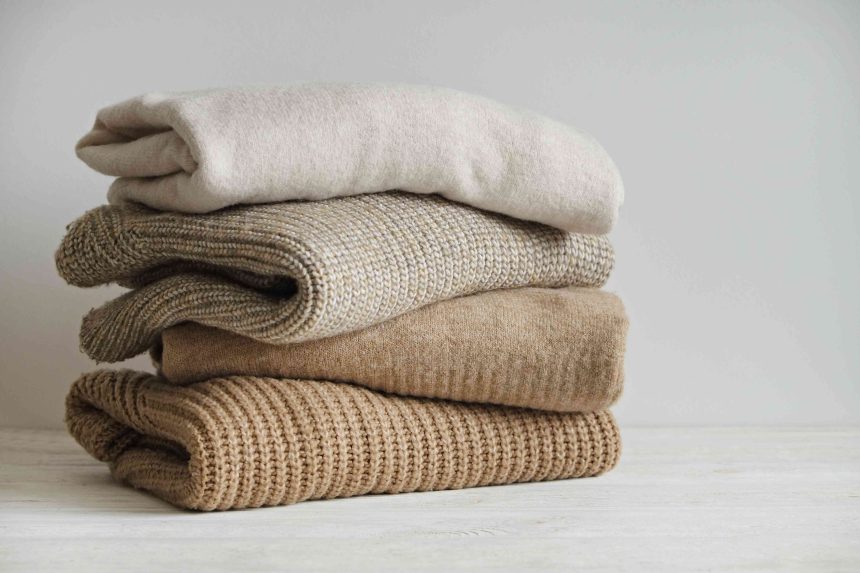Wool clothing can be thick and heavy to protect you from the elements or light as a feather so your skin can breathe. Knitted or woven from the natural fleece of sheep, wool fibers are durable, versatile, and easy to care for. The most important elements in wool care are washing and drying temperatures.
We spoke with a laundry expert for the best advice on what water temperature is safe for washing wool. Learn how to keep your wool socks, sweaters, and jackets looking great.
Meet the Expert
Zach and Jerry Pozniak are the owners of Jeeves New York, a luxury dry-cleaning company, as well as the authors of The Laundry Book.
What Is the Right Temperature to Wash Wool?
“Wool is an animal fiber. Think of animal fibers like your hair; it’s important to care for it properly to keep it soft, less tangled, and protected,” the Pozniaks say. “One way to do that is to use the right water temperature and detergent.”
Whether washing wool on the gentle cycle in a washer, or hand washing, the water should be cold or tepid (slightly warm). “Hot water will cause wool shrinkage”, says Zach Pozniak.
Wool fibers have small barbs that tangle and lock, creating a non-raveling felt, when they are subjected to hot water. A wool sweater that has shrunken when washed in water that is too warm may be able to be saved; however, one washed in hot water is usually ruined.
Want more cleaning and organizing tips? Sign up for our free daily newsletter for the latest hacks, expert advice, and more!
Can You Put Wool in the Dryer?
“The best way to ruin a wool garment is to put it in the dryer,” adds Jerry Pozniak. “You must lay the garment flat and let it air-dry.” Tumbling drying has temperatures that cause shrinkage and hanging wet wool garments will cause stretching.
Wool sweaters, socks, and accessories should be laid flat on an absorbent towel and rolled up to absorb excess moisture. Then lay the items flat on a mesh drying rack or a clean, dry towel to dry slowly away from direct heat sources.
Expert Tips for Washing Wool
Wash or Dry Clean?
While wool fibers are washable, a wool garment may not be. Structured wool clothing, such as outer coats, blazers, and men’s suit coats, should always be dry-cleaned. The fabrics used to create the inner structure in these garments may be destroyed or become misshapen when washed. There is no way to reverse the damage once this happens.
Unstructured wool clothes, such as sweaters, scarves, hats, gloves, socks, and unlined jackets can safely be machine or hand-washed.
Pretreat Stains
Use an enzyme-based stain removal product or a dab of wool wash to pretreat visible stains. Work the cleaner into the wool fibers with your fingers, then set the garment aside for at least 10 minutes before washing it.
Use the Right Type of Detergent
Using a wool wash or a gentle detergent is recommended when washing wool.
“Most of these detergents are “no rinse” products and purposefully leave behind conditioners on the wool fibers to protect them,” the Pozniaks share. “These detergents should help prevent your garments from pilling and feeling rough and scratchy.”
Treat Wool Gently
If hand washing wool, do not scrub the fibers harshly or wring the garment. When machine washing wool, especially sweaters or loosely knit items, use a mesh delicates bag to protect the item from snags and abrasion.
Button or zip clothes to help them keep their shape and prevent wrinkles. Between washings, always empty pockets and remove any accessories that might pull on the fibers like belts and jewelry.
Maintain Color Consistency
If you have a two-piece wool ensemble, always wash both pieces at the same time. This will help keep the color and wear to the fibers more consistent.
Remove Wrinkles the Right Way
To remove wrinkles from wool or sharpen labels and pocket trim on structured garments, you can use an iron or a clothes steamer. If ironing, use a sturdy ironing board, steam iron, and a protective cloth between the iron and the garment when pressing wool to prevent damage to the fibers.
A clothes steamer works well to relax wrinkles. Hang the wool garment from a study hanger and follow the steamer’s instructions. Both pressed and steamed wool garments should be allowed to dry completely before wearing to prevent set-in wrinkles.








